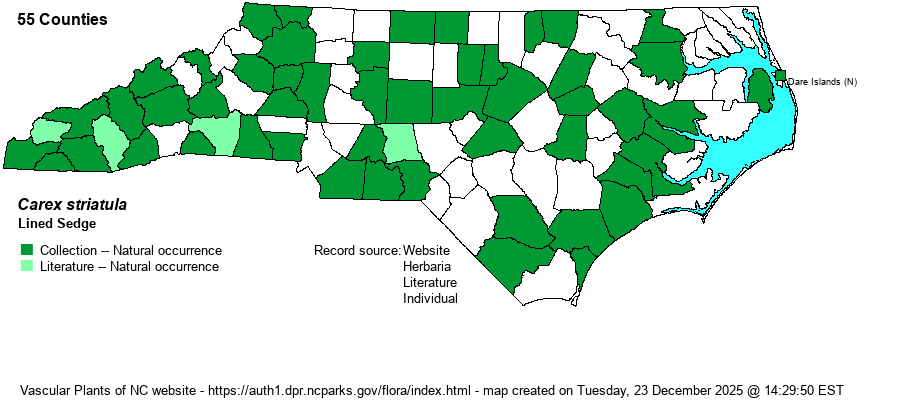| Author | Michaux | |
| Distribution | More-or-less throughout the state. Gaps probably will be filled in with additional collecting.
Southeastern NY to KY and AR, south to FL, LA, and TX. | |
| Abundance | Fairly common nearly throughout; perhaps uncommon in the far eastern counties. The State Rank could easily be moved to S5, as should the Global Rank to G5. | |
| Habitat | Dry to mesic hardwoods and mixed forests on slopes and in ravines. Soils often circumneutral. Less often found in bottomlands than in uplands, especially in oak-hickory forests. | |
| Phenology | Flowering and fruiting May-June. | |
| Identification | Lined Sedge belongs in the section Laxiflorae, so care must be taken when identifying. Basal parts of the plant are pale brownish (not red-purple) and spikes are loosely flowered (contra C. blanda, C. crebriflora, and some C. styloflexa). From C. styloflexa, it is told by the much shorter stalk to the lowest spike (vs. very long, arching or drooping). From C. radfordii, told by the longer blades of the spike bracts (6.5-15 cm long vs. 5-8 cm). From C. laxiflora, it is told by the longer mature achenes (2.2-3 mm vs. 1.8-2.2 mm). | |
| Taxonomic Comments | No taxonomic issues per se, though Weakley (2018) states: "The distinction of this species as separate from C. laxiflora is problematic and requires additional study."
The genus Carex is the largest in North America, and among the largest in the world. In temperate and boreal regions, Carex is often the dominant or co-dominant ground layer in many habitats. Seeds (achenes) are valuable food for birds and small mammals, while foliage is used by birds and mammals to make nests and as food by mammals. Species of Carex often look vastly different from one another -- spikes erect vs. drooping, tiny inflorescence vs. whopping, culms leafy vs. naked, perigynia beaked vs. beakless, stems densely bunched vs. single, etc. The genus has been divided into many sections (or groups), based on shared characters; some taxonomists have suggested that these be different genera, but that proves unworkable (so far). All Carex share the feature of a perigynium (an outer covering) which completely surrounds the achene (seed). This covering may fit tightly or loosely (like a small bladder), depending on which group or species. Details of perigynia shape, ornamentation, presence and size of beak, number of striations (or veins) are all important ID features. In recent years Rob Naczi and colleagues have stressed the importance of arrangement of perigynia -- whether spiral (3+ ranks) or distichous (2-ranked) -- and have named a number of new species as well as split off some older synonyms. Therefore, RAB's (1968) key, excellent for its time, can only be used in a general way today. Members of some sections of Carex are difficult to key out (notably Ovales, Laxiflorae, Griseae); this is in part due to variation among individuals of a species, or failings of the key. FNA has drawings of most species and some species may be found in two or more places within a key, to acount for variability. New species to NC, and new to science(!), continue to be found in NC. | |
| Other Common Name(s) | None | |
| State Rank | S4 [S5] | |
| Global Rank | G4G5 [G5] | |
| State Status | | |
| US Status | | |
| USACE-agcp | | |
| USACE-emp | | |

